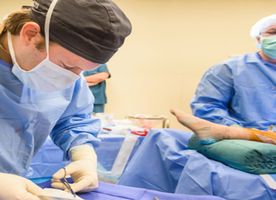Osteoarthritis Treatment in Vigo
Search and Compare the Best Clinics and Doctors at the Lowest Prices for Osteoarthritis Treatment in Vigo






Osteoarthritis Treatment at Povisa Hospital in Vigo, Spain
Our partner clinics in are accredited by the following associations




















































































































































No Time?
Tell us what you're looking for and we'll reach out to the top clinics all at once
WHY US?




















































































































































No Time?
Tell us what you're looking for and we'll reach out to the top clinics all at once
What does a Osteoarthritis Treatment Procedure Involve?
Knee injections
For people with symptomatic knee osteoarthritis, an artificial joint fluid injection can be an option. The fluid lubricates and cushions the joint so it can move more easily. Your doctor may give you a single-dose injection into your knee joint, or you may need a series of injections.
Corticosteroids Injections
Injections of corticosteroid medications can reduce inflammation, decreasing pain, and swelling in joints. Your doctor will usually give corticosteroids by injection. During corticosteroid injections, the area around your joint is numbed. Then, the doctor places a needle into space within the joint and injects the medication. The number of injections you can receive is usually limited to three or four injections per year.
Therapy
-
Physical therapy – a physical therapist can work with you to develop an exercise regimen that suits your needs. The exercise regimen can help reduce pain, improve muscle strength, improve balance and gait, and increase the range of motion of the stiff joints. If you need any additional help, physical therapists can also help you learn to use assistive devices, such as braces, splints, and shoe inserts. Also, your physical therapist can show you how to use canes or walkers.
-
Occupational therapy – an occupational therapist can help you find new ways to do everyday tasks without putting extras stress on your painful joints. For instance, if you have knee osteoarthritis, using a bench in the shower could help relieve the pain of standing.
Surgery
Severe cases of osteoarthritis may need surgery to repair or repair the damaged joints. There are some types of surgery that can be used, including:
-
Joint replacement – also known as arthroplasty, this procedure involves removing the damaged joint surfaces and replacing them with prosthetic made from metal or plastic. The most common types of joint replacement are knee and hip replacements.
-
Arthroscopic surgery – during this surgery, damaged or torn cartilage is trimmed from a joint. In some cases, doctors use this procedure to remove bone spurs. The procedure is performed using an arthroscope, which is a small tube with a small camera on its end.
-
Bone realignment – the type of surgery used to realign bones that are damaged by arthritis is called an osteotomy. In a knee osteotomy, your surgeon makes an incision across the bone either below or above the knee. Then, a wedge of bone is added or removed. This is done to shift your body weight away from the worn-out part of the knee.
- Bone fusion – during this surgery, your surgeon permanently fused the bones in a joint together to increase stability and reduce pain. This surgery is also called arthrodesis.
How Long Should I Stay in Vigo for a Osteoarthritis Treatment Procedure?
Your length of stay in Vigo can vary, depending on the type of treatment you undergo. For knee and corticosteroid injection, you may be able to leave for home the next day. If you have physical and/or occupational therapy, your length of stay depends on how many visits are needed for your case. On average, you may need to stay in Vigo for 4 to 8 weeks for therapy. With surgery, you need to stay in the hospital for 1 to 5 days, and stay at least 7 to 10 more days in the area after you are discharged.
What's the Recovery Time for Osteoarthritis Treatment Procedures in Vigo?
The severity of your osteoarthritis, the type of treatment you have, as well as your age and general health, determines your recovery time. For knee injections, corticosteroid injections, physical therapy, and occupational therapy, you should be able to return to your normal activities as soon as you feel ready and you when you do not experience any symptoms that interfere with your ability to do daily tasks. With surgeries, you may be able to resume most activities, including work, within 6 weeks. However, it may take around 6 months until you are 100% recovered.
What sort of Aftercare is Required for Osteoarthritis Treatment Procedures in Vigo?
Your doctor should give you detailed aftercare that you will need to follow. If you undergo surgery, the aftercare may include:
-
Take pain medicine as directed
-
Rest between activities as needed
-
Elevate and put cold packs on the affected area
-
Try home exercise (as recommended by your surgeon).
It is important that you follow the instructions your doctor gives you to help you heal quickly and to avoid further complications.
What's the Success Rate of Osteoarthritis Treatment Procedures in Vigo?
The success rate varies for each treatment type. Osteoarthritis treatment is known to be highly successful in providing pain relief, keeping mobility, and improving quality of life. However, there are still some side effects and risks you need to be aware of, especially with injections and surgery. These include:
-
Worsening joint damage
-
Infections
-
Blood clots
-
Wearing out of artificial joints
-
Limited range of motion in the joint.
Are there Alternatives to Osteoarthritis Treatment Procedures in Vigo?
Sometimes, lifestyle and home remedies are enough to manage the symptoms of osteoarthritis. You can try low-impact exercise and lose some weight to reduce pain and relieve some pressure. You can also consider movement therapies, assistive devices, and acupuncture as the alternatives to osteoarthritis treatment.
This information has been accurately sourced and verified by a medical professional for its accuracy, however, we strongly recommend you to consult with your doctor before pursuing medical procedures overseas.
